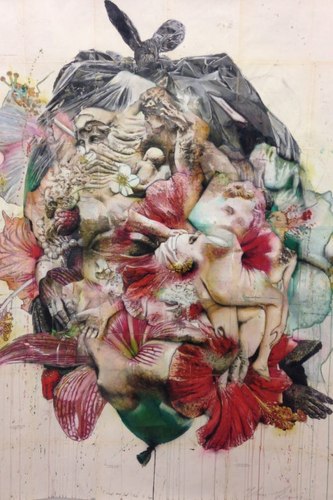
Thomas Lerooy, I send my bad ideas to heaven, 2015, Pages de livres anciens assemblées et collées, encre de Chine, aquarelle, acrylique, crayon, bombe, colle, vernis, 196 x 140 cm © Bertrand Huet - Tutti Images, Courtesy Galerie Nathalie Obadia, Paris/Bruxelles
Harking back to its origins, when at the start of the twentieth century the Petit Palais used to purchase the works of living artists to build up its fledgling collection, the Musée des Beaux-Arts de la Ville de Paris is inviting art of the twenty-first century to dialogue with its celebrated collections of ancient art.
The Petit Palais is thus renewing its ties with contemporary art by giving carte blanche for the first time to Thomas Lerooy, a Belgian artist born in 1981. His works – twenty or so sculptures and drawings – have been installed in the rooms of the permanent collections on the first floor, with a brief incursion onto the patio garden. Just outside the museum on the side of Avenue Winston Churchill, visitors are met by a Manneken-Pis (Petit Jean) revisited, a masked tribute to the sculptor Jérôme Duquesnoy (1570–1641) as well as being an introduction to the dreamlike and burlesque world of Thomas Lerooy.
Although it may seem surprising in a classical setting, Thomas Lerooy’s oeuvre has close and productive ties with ancient art, on which it draws, the better to exploit it for its own purposes. Reference is made to ancient Roman art as much as to that of the Renaissance, Classicism or Mannerism. An ancient-style nude pierced by glass bottles (Speaking in Tongues), putti with a skull’s head (The Kiss) or St Sebastian pierced by an arrow (Falling Apart Together) – each work is inspired by the sources of Western art. Lerooy’s exploitation of symbols, both religious and profane, illustrates his approach to “the current significance of motifs from art history, and of the relations between a work of art, the space and the viewer”. - Tanguy Eeckhout, 2007
This approach finds a new means of expression and enrichment through contact with the collections of the Petit Palais, which give rise to exchanges as peculiar as they are instructive throughout the exhibition. An example is the eloquent face-to-face between the sculpture Destroy Everything You Touch and the monumental Christ on the Cross by Léon Bonnat (1833–1922). On contact with this realist painting of the nineteenth century, Lerooy’s contemporary work is permeated by a value that goes beyond the image of the sacrifice suffered by our Lord for the redemption of man’s sins. Conversely, the silver-plated bronze nail in Lerooy’s sculpture adds to our understanding of the Crucifixion by offering us here below with a different interpretation of the acme of martyrdom. The exhibition is punctuated by such individual dialogues, which cast a new light on the ancient works of the Petit Palais while giving an insight into the inner world of Thomas Lerooy.
Like a danse macabre, the dreams and imaginings of the Flemish artist wheel around the visitor in joyous frenzy. Monsters, skeletons and hybrid creatures inhabit Lerooy’s graphical and sculptural universe that straddles the boundary between Symbolism and Surrealism. The image of the skull, which is omnipresent in his work, makes reference to the briefness of our presence on Earth, a theme inherent in the vanities of the seventeenth century, of which the Petit Palais has some fine examples.
The allegorical and heavily meaningful nature of the works is combined with a mischievousness typical of their Flemish origin that, from Brueghel to James Ensor, has always taken the edge off the sinister nature of Belgian art. Humour – an antidote to ugliness – operates in Lerooy’s works, just as it injects life into the coarse Caravaggesque paintings of vice and misery in Rome, to be seen in the exhibition Les Bas-fonds du Baroque, on show at the Petit- Palais during the same period as that of Thomas Lerooy.